|
Biology - 1998 ( I.C.S.E)
You are on
Questions - 3 & 5
Q 3
(a) Moist
germinated seeds were placed in thermos flask A, and germinating
seeds which were placed in thermos flask B. Thermometers wre
inserted in the flasks and the mouth of each flasks plugged with
moist cotton wool. The two flasks were fixed upside down as
shown in the diagram. The initial temperature on both thermometers
was noted . After about 48 hours, the temperature in flask A
was found to be much higher than that in flask B
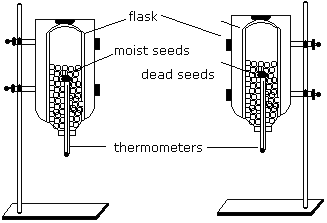
i) State the object of
using the apparatus
ii) Explain why a rise in temperature occurs
in flask A
iii) If 5% formalin was not used after boiling the
seeds, the temperature of flask B would have risen
considerably. Explain
iv) Why were the flasks inverted
?
|
Q 3 (b) The following
diagram is that of a human brain. Guidelines 1 to 5 indicate
different parts of the surface of the brain and these are as
follows :
1. Frontal lobe of cerebrum
2. Temporal lobe of cerebrum
3.
Occipital lobe of cerebrum
4.Cerebellum
5. Medulla
oblongata |
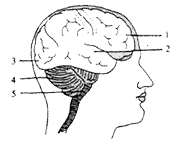 |
study the diagram
and answer the following questions :
(I) What handicaps
would result from :
i) damage to part numbered 3 ?
(ii) damage
to part numbered 4 ?
(II) Mention one main
function of each of the parts numbered 1, 2and
5.
Q 4(a) The
following diagram represents a mammalian kidney tubule and its
blood supply. Parts indicated by the guidelines 1 to 8 are as
follows :
1.U-shaped loop of Henle.
2. Proximal convoluted
tubule with blood capilliaries
3.Bowman's capsule
4.Afferent
arteriole from renal artery.
5. Glomerulus
6.Venule to renal
vein
7.Collecting tubule
8. Distal convoluted tubule with
blood capillaries
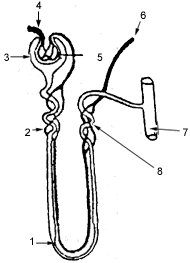
study the diagram
and answer the following questions in each case
:
i)Where does ultrafiltration take place /
ii)Which
structures contains the lowest concentration of
urea ?
iii)Which structures contains the highest
concentration of urea ?
iv)Which structures contains the
lowest concentration of glucose ?
v)Where
is the most water reabsorbed ?
Q 4 (b) A well
watered healthy potted plant with variegated leaves was kept
in darkness for about 24 hours. It was then set up asshown in
the diagram below and exposed to light for about 12 hours. At the
end of this time, leaf X and leaf Y were tested for starch.
Study the diagram and answer the questions that follows :
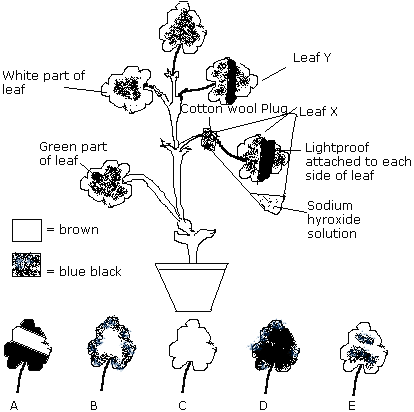
i) why was the plant
initially kept in darkness for 24 hours ?
ii) What is the
function of sodium hydroxide solution in the flask ?
iii) select
the correct leaf from the five available choices shown in the
diagram as A,B,C,D,and E . Rewrite the
correct answer by filling in the appropriate letter for the question
that follows :
1) After the starch test, leaf X would look like
..............................
2) After the starch test, leaf Y
would look like...............................
iv) The experiment
with leaf Y shows that photosynthesis requires the presence of
certain factors. Mention any one factor.
Q 5 (a) State one
function of each of the following :
i) Ciliated epithelium
lining the respiratory tract
ii) Epiglottis
iii) Skin
iv)
Mitochondria
v)Medulla Oblongata
Q 5 (b) The
following diagram represents a plant cell after being placed
in a strong sugar solution . Guidelines 1 to 5 indicate the
following :
1. Cell wall
2. Strong
sugar solution
3. Protoplasm
4. Large vacuole
5.
Nucleus
study the diagram
and answer the questions that follow :
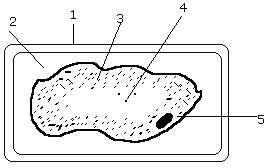
i)What is the state of the
cell shown in the diagram ?
ii)Name the structure which
act as a selectively permeable membrane.
iii) If the cell had been
placed in distilled water instead of strong sugar solution , which
features would not have been present ?
iv) If the cell in the
diagram possessed chloroplasts, where would these be present
?
v) Name any one
feature of this plant cell which is not
present in animals cells.
| 